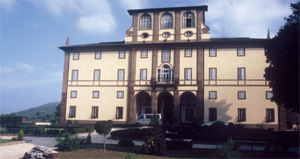|
A Conchological event at Frascati, Italy? It was an invitation from Sonia Fuschi which I simply could not refuse. An expedition to the district of crisp white wines, elegant palazzo surrounded by beautiful gardens with tall cypress trees, and the added excitement of a treasure hunt among the dealers’ wares. The Villa Tuscolana, the historic conference hotel which was out home for half a week, with its cool corridors, antique furniture and excellent restaurant, was historic because of its connections with the great Roman Orator Cicero, with the Sforzas, the Renaissance princes of Milan, those rich and famous patrons of Bramante and Leonardo da Vinci, and with the conqueror of Italy, Napoleon Bonaparte and his younger brother Lucien. Sonia and her team of helpers made detailed and smoothly successful arrangements for us, including convivial suppers at wonderful restaurants in Frascati and at elegant Castel Gandolfo with its beautiful views over the moonlit lake below. There were showcases of shells, each a first class specimen, on exhibition to the public and which invited them into the world of Conchology, with a special emphasis on gaining the interest of young children. The Mayor of Frascati attended, so did a minister responsible for conservation and the environment, as well as the president of the college of wine tasters, though unfortunately he did not bring any samples! The exhibition also included such unexpected delights as a demonstration of cameo carving, of beautiful shell jewellery and ornaments, as well as more humble items such as a DVD on the physical process of collecting sea shells which ought to tempt any young child onto the beach. Peter Dance, as Guest of Honour, continued this theme in his address, starting with several shell games suitable for young children, and Koen Fraussen gave a talk about his famous whelks. Whilst there a walk down the lane from our high point on the Albani Hills above Frascati, overlooking the Tiber valley and the Italian capital revealed a modest Classical Renaissance style church attached to a monastery of the Capucin monks of St Francis. Outside is a notice stating that it also included a museum of Ethiopia. It seemed such an odd combination, but I had noticed in the church a large marble statue and monument to a Bishop Gugliemo Massaja who had spent 35 years in the late 19th century ministering to the desert tribes of Ethiopia. I rang the doorbell, which was presently answered by a handsome young friar, who gave me a personal tour of the Museum with a commentary in rapid Italian, Fortunately I had become sufficiently conditioned to the language by this time to be able to follow him. Amongst other artefacts the museum contained sadly realistic locally made drawings of the brutal wars which raged among the tribes at the time. After such carnage, the Bishop would walk over the battlefield in search of any boy child left alive – the girls and women seem to have been killed or carried away. The rescued children were taken to a monastery and were later sent to a school which the Bishop had founded. During his ministry the Bishop made many journeys on foot along the shores of the Red Sea and as far as Aden (now S. Yemen but them a British colony), often suffering exile and imprisonment along the way. Among the items which he had brought back I was amused to note a collection of shells from the Red Sea. In pride of place stood a full-size specimen of Strombus (Tricornis) oldi, and beside it by way of a contrast was a strip of leather onto which had been sown a few Cypraea moneta, the very epitome of Franciscan poverty. I was so impressed and absorbed by all I had learnt that I completely forgot to photograph the church. On joining some fellow conchologists at coffee beneath the hotel portico, Peter Dance offered to return with me. On the damp causeway beneath the apron of the church, which the monks must have used for centuries when walking downhill to Frascati, Peter found a large and colourful specimen of Cornu aspersum, with which he was highly satisfied. We conchologists are surely a curious bunch of “Odd Bods”! This is an abridged version of Janet’s article which first appeared in the British Shell Collector’s Club magazine, Pallidula, Vol 40 no 1 April 2010 – Ed. |

Figure 1: The Villa Tuscolana
Figure 2: Peter Dance beside the Capucin Monastery |
Shells Revealed in Unusual Places
Issue
23
Page
21

